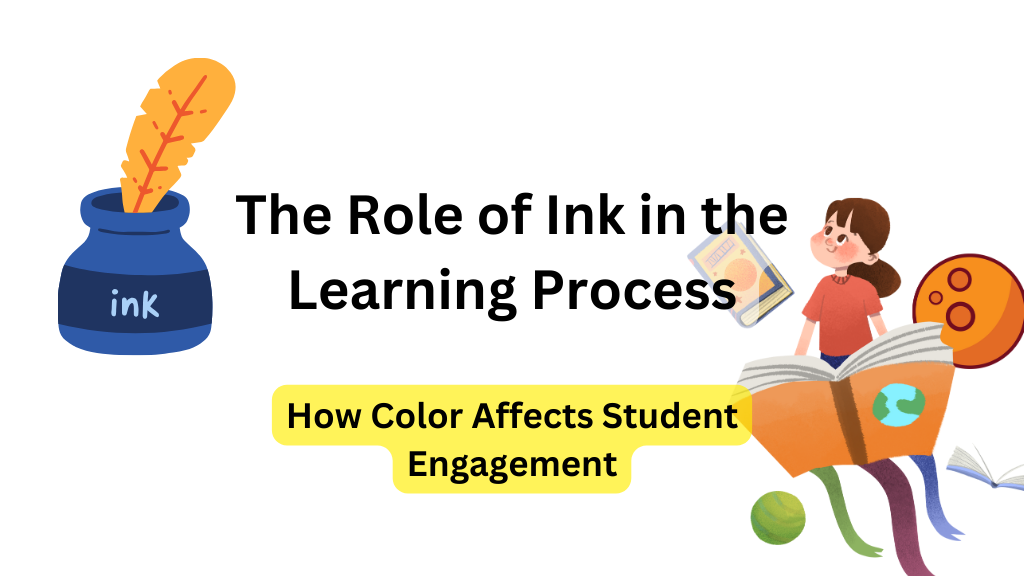
So there you are, the buzz of the classroom humming around you, and you've got your pen poised—ready to take on the world, one scribble at a time. It's funny when you stop to think about it; that little pen is pretty much a superhero in disguise.
It turns those empty lines into a personal treasure trove of thoughts, ideas, and late-night eureka moments. Whether it’s jotting down a professor’s wisdom in classic blue or dousing a draft in bold corrections, that pen—full of ordinary ink—is your steadfast companion through the rollercoaster of learning. It’s a part of every late study session and every crammed-in coffee shop corner. Pretty neat when you think about it, huh?
The significance of color in learning and memory recall


Isn't it amazing how a splash of color can completely change the game when it comes to studying? Picture this: you're flipping through your notes, and suddenly, those key points highlighted in bright yellow jump out at you. Or maybe it's the flashcards with terms in green that somehow seem easier to remember. It's not just about making your notes look more attractive (though that’s a nice perk, too).
Colors actually play a big role in how our brain sorts and stores information. It's like they create these mental shortcuts that help us recall the bits we need just when we need them. So, when you reach for that highlighter or choose a pen for your study session, you're not just making your notes pop—you're setting up signposts for your brain to navigate through all that info. Pretty cool, right?
In this blog post, we're going to see just how much the colors we see in our notes and textbooks can really make a difference. It's about how those dashes of color not just catch our eye but can actually play a big part in how well we focus, how much we enjoy learning, and the grades that come out at the end. It turns out that choosing ink colors might be just as important as the words we're writing down.
A Splash of History: Ink in Educational Traditions
Picture it: way back before we had our smartphones and laptops, even before the trusty ballpoint pen, there was ink. And not just any ink—we’re talking about the homemade kind that would've had your hands, desk, probably even your face all smudged up. This was the stuff of scholars and scribes, carefully concocted from soot, water, and sometimes a bit of wine (for color, not for fun—though who's to say they didn't have a little sip now and then).
Fast forward a few centuries, and the game changed big time with the printing press. Now, that's when ink really had its moment. Imagine the scene: huge, clunky machines clattering away, pressing ink onto pages that would become the books that filled libraries. And not just any libraries, but the first ones where you didn’t have to be a big shot to get in. This was knowledge going public, and ink was the star of the show.
Now, skip ahead to the 20th century. Classrooms all over the place started to buzz with the sound of pens scratching on paper. Fountain pens were the bees' knees for a while, but they were kind of a hassle, always needing a refill. Then came the ballpoint pen, and it was a game-changer. No leaks, no mess, and ready to write whenever you were.
These days, we've got all kinds of colors to play with, not just for writing but for highlighting, too. Ever think about why your highlighters are neon? It’s because those bright colors snap us to attention, making sure we don’t miss the important stuff.
So there you have it—a quick stroll down memory lane with ink. It started as a simple tool, just a way to get words on paper. But look at it now—it's not just about the words; it’s about making them stick, both on the page and in our minds. Ink's not just a substance; it's a sidekick in our learning adventures, one that's been with us every step of the way, from those ancient scribes to today's color-coded study sessions.
Historical significance of colored ink in different cultures


Oh, colored ink! It’s like a secret code that’s been passed down through generations, carrying stories and meanings in every hue. Let’s take a whirlwind tour through the past and see how different cultures have painted their worlds with it.
Starting in ancient China, black ink wasn't just black ink. It was a symbol of mystery and strength, crafted with care for calligraphy that wasn’t just writing; it was art. But then, there was red. Red ink was so special that it was reserved for emperors and high officials — their stamps and seals pressing authority onto paper.
Jumping continents over to Egypt, they were all about making a statement. Hieroglyphs were pretty on point in just black, but when they broke out the reds, blues, and yellows? That's when things got really interesting. They used bright, bold colors to highlight the important gods and phrases, making sure they popped off the papyrus.
Now, scoot over to medieval Europe. Monks in dimly lit monasteries would spend hours, days, heck, even months, meticulously crafting illuminated manuscripts. These weren't just written records; they were masterpieces dripping with golds, blues, and crimsons that told stories more vividly than any words could.
In the Islamic world, calligraphers were mixing up inks to write the Quran, and their colored inks were meant to inspire as much as they were to inform. They believed that the beauty of the script increased one's understanding, and colors like gold and lapis lazuli brought the divine words to life.
Fast forward to the Renaissance, and you’ll see that artists like da Vinci weren’t just using color for kicks; they were pushing boundaries, using ink to sketch out ideas that were way ahead of their time.
And it wasn’t just about looking pretty or being powerful; colors had meaning. Take Japan, for instance. Sumi-e painting was all about the shades of black, but once in a while, they’d add in a touch of red to symbolize energy and life.
So here we are, centuries later, and we still reach for that red pen when we want something to stand out. We still feel that little bit of awe when we see a beautifully penned blue invitation. It seems like no matter where or when, colors have this way of speaking without saying a word, creating connections across time and cultures. Isn’t that just the coolest thing?
Transitioning from quills to modern-day pens: How ink choice has expanded


Oh, let's zoom back in time for a sec. Picture it: you're sitting in a candle-lit room, a quill in your hand, and a pot of ink by your side. That was the OG writing setup, and let's be honest, it had a certain charm to it. But, if you’ve ever tried using a quill, you know it's no walk in the park. It's all dip, write, repeat – and hope you don’t end up with more ink on you than on the paper.
Fast forward a few hundred years and enter the fountain pen. It was like the cool new kid on the block. A little less messy, a bit more reliable, and it made writing feel like butter. But fountain pens had their own quirks – they needed refilling, and if you weren't careful, you'd get the dreaded ink blobs.
Then, guess what changed everything? The ballpoint pen. This nifty invention came on the scene, and it was a total game-changer. It was ready whenever you were, with no need for a refill every few pages. Plus, you could say goodbye to ink smudges on your hands and face.
But it's not just about going from messy to mess-free. The real magic happened when ink choices exploded. We went from "you can have any color as long as it's black" to a rainbow in a drawer. Suddenly, you could grab a pen in just about any color you could dream of. Notes became less about what you wrote and more about how you wrote it – with flair, with color, with personality.
And, let's not forget about the markers and gel pens that came into the mix. If you were a kid in the 90s or early 2000s, you know what I’m talking about. That sea of glitter and neon turned book reports into art projects, and studying became a little less snooze-fest and a little more rock concert.
So, there you have it. From a lone quill and a pot of black ink to a world where you can color-code your life with a pen for every mood and message. Ink choice has become more than a practicality; it's a way of expressing who we are and what we think, all while making the mundane task of writing a whole lot more fun. Who would’ve thought something as simple as ink could do all that?
Color Coding: A Student's Best Friend
Think of your study materials as a canvas and colored inks as your palette. By using different colors strategically, you can create a study masterpiece that's not only visually appealing but also cognitively beneficial.
Technique 1: The Highlighter Hierarchy
Imagine cracking open a textbook and seeing a wall of text. Overwhelming, right? Here’s where your highlighters come in. Use yellow for main ideas, pink for supporting details, and blue for definitions. This color-coding creates a visual hierarchy, helping you navigate through pages with ease.
Technique 2: Margin Magic
Margins are your study sidekick, the unsung hero of your textbooks. Jot down summaries or questions in the margins with colored pens. Use green for questions you have, red for important points to remember, and purple for summary statements. This side-note system makes review sessions a breeze.
Technique 3: The Flashcard Fiesta
Flashcards are like mini billboards for your brain, and color makes them unforgettable. Use one color per subject or topic. For example, use orange for Spanish vocabulary and teal for historical dates. The consistent use of color helps trigger your memory when it’s go-time for exams.
Technique 4: The Mind Map Method
Mind maps are like the GPS for your brain's ideas. Start with a central idea in the middle, then branch out with different colors for different themes or concepts. It’s not just about making it pretty; it’s about creating a roadmap for your thoughts, with each color representing a different route of information.
Technique 5: The Progressive Palette
Start your study session with one color and switch colors every hour or after a certain number of pages. This gradual color transition helps keep your brain engaged. It's like having a bookmark that you don’t just see, but feel.
Technique 6: The Emotional Connector
Colors have feelings too! Use them to connect emotionally with the material. Feeling joyous about a topic? Go with yellow. Something needs a serious tone? Break out the navy. Using colors to match the emotional tone of the content can help in recalling the information later because emotions are powerful memory enhancers.
Technique 7: The Organizational Oasis
Keep your notes tidy and colorful. Use headers in one color, subheaders in another, and bullet points in a third. This turns your notes into a neatly organized, color-coordinated treasure map, where X marks the spot for the most important info.
Technique 8: The Testing Tint
When quizzing yourself, use a particular color for writing down what you think you know, then use a different color to correct or add information. This visual cue separates what you know from what you need to learn, making gaps in knowledge stand out.
These strategies are more than just fun; they're functional. They turn the task of studying into an art form, where the use of color is both a mnemonic device and a motivator. So, grab those colored pens and highlighters and paint your way to a successful academic masterpiece.
Practical tips for color-coding notes and organizing materials
Let’s spill some colorful beans on how to turn your notes from a drab, all-you-can-read buffet into an organized, color-coded feast for your eyes and brain. Color coding isn’t just about making your notes pretty; it’s about making them as useful as a Swiss Army knife on camping day. Here’s how you can do just that:
Tip 1: Choose Your Palette Wisely
First up, pick your colors. But remember, it’s not a fashion show. Choose colors that you can consistently associate with certain topics or subjects. Maybe blue for math because it’s as deep as the ocean of numbers, green for science to match the color of those lab goggles, or red for history because... well, there’s a lot of intense stuff that went down.
Tip 2: Keep It Consistent
The key to color coding is consistency. If blue is for important dates in your history notes, then that royal blue should only be bowing to dates. If you start mixing it up, you’ll just have a colorful mess that’s about as helpful as a chocolate teapot.
Tip 3: Don’t Overdo the Rainbow
You might be tempted to turn every page into a Mardi Gras parade, but hold your horses. Too many colors can actually be confusing, and you’ll end up needing a codebreaker. Stick to 3-4 main colors to keep things simple and effective.
Tip 4: Use What You’ve Got
You don’t need to break the bank for a deluxe set of 64 colored pens. Even the humble pack of four – blue, black, red, and green – can be the A-team for your notes. Use them wisely, and they’ll do wonders.
Tip 5: Highlight with a Purpose
When you highlight, don’t go on autopilot. Use specific colors for specific things – like yellow for key terms, pink for definitions, and orange for stuff that’s guaranteed to be on the test. But remember, the goal is to highlight, not to paint the entire text yellow.
Tip 6: Margins are Your Friends
Write summaries, questions, or memory cues in the margins. Using the same color for the same type of margin note means with just a glance, you’ll know where to find your summaries or what questions you had.
Tip 7: Sync Your System
If you’re going digital and paperless, sync your color-coding system across all your devices. This way, whether you’re on your tablet or laptop, your brain knows that purple always points to professor’s insights, no matter the screen.
Tip 8: Review and Revise Your System
What works at the start might need tweaking as you go. Maybe you find out that green isn’t striking enough for key formulas, or red is too alarming for your peaceful poetry notes. Adjust your colors as needed – just don’t change them as often as you change your socks.
Tip 9: Organize Your Materials
Your notebooks, folders, and binders should follow the same color code. Blue notebook for math? Match it with a blue folder for math handouts. This way, you won’t be the one frantically flipping through a red notebook looking for your green bio notes five minutes before an exam.
Tip 10: Teach Your Colors
Once in a while, explain your system to someone else. Teaching reinforces your own understanding and commitment to the system. Plus, it might just help a buddy out.
By following these practical tips, you’re not just studying; you’re giving your future self the gift of time and clarity. So go ahead, give those notes a color bath – just make sure it’s more of a relaxing spa day and less of a color run obstacle course.








